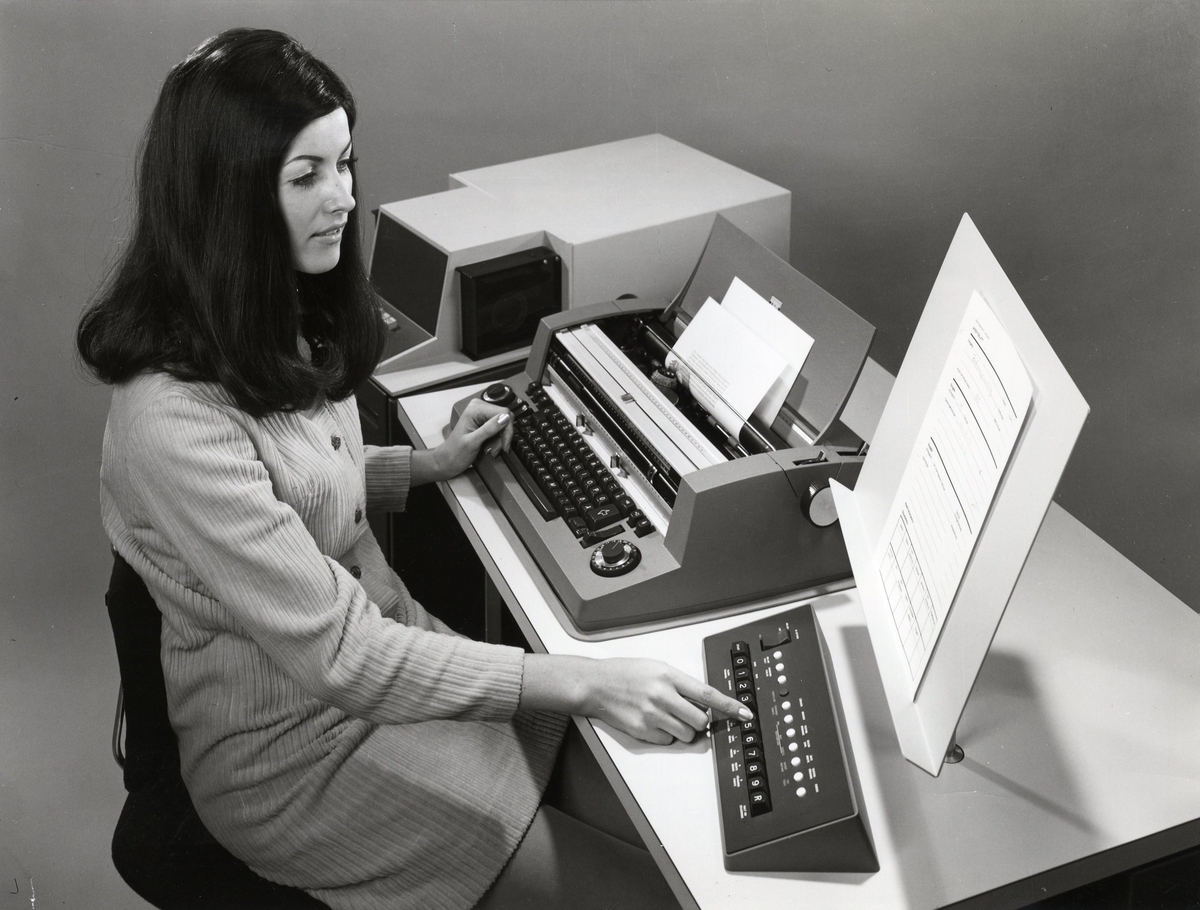
Introduction
This is part 1 of a two-part post. See also The IBM Magnetic Tape Selectric Composer - Part 2.
For a few years now, I have been collecting IBM typewriters. That includes the Selectric, probably the best known of the IBM typewriters with its famous “golf ball” type element, but also older-style “typebar” typewriters, starting with the Electromatic, and later Executive typewriters which feature proportional spacing and carbon ribbon. All of these are electromechanical machines.
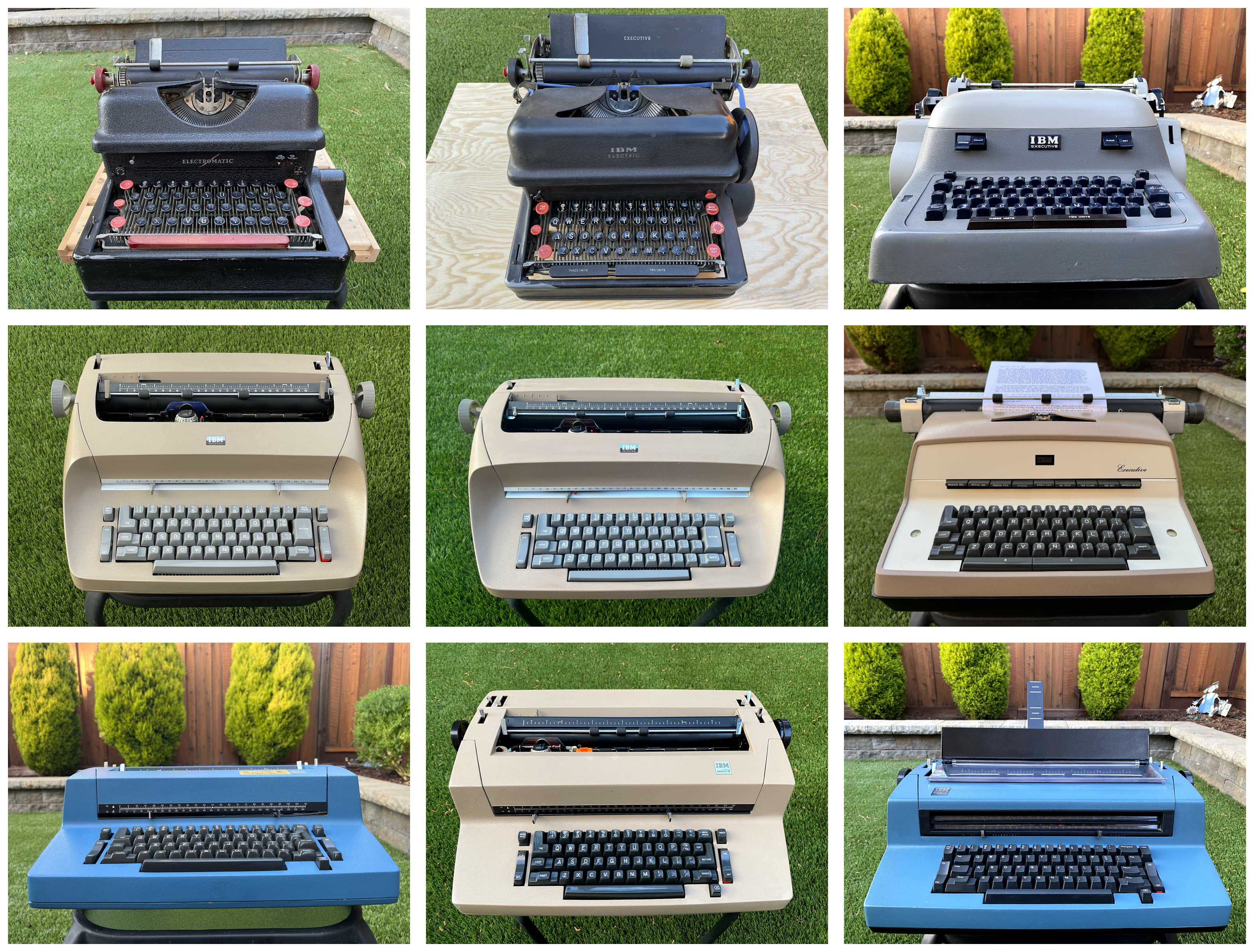
But there is more to the world of IBM typewriters than those. During the 1950s already, IBM typebar typewriters modified by third-party companies were used as computer terminals, such as for the Bendix G-15 or the PDP-1. Such computer systems cost between half a million and over a million 2024 dollars. Compare the terminal below with the IBM Model A Executive in the montage above.
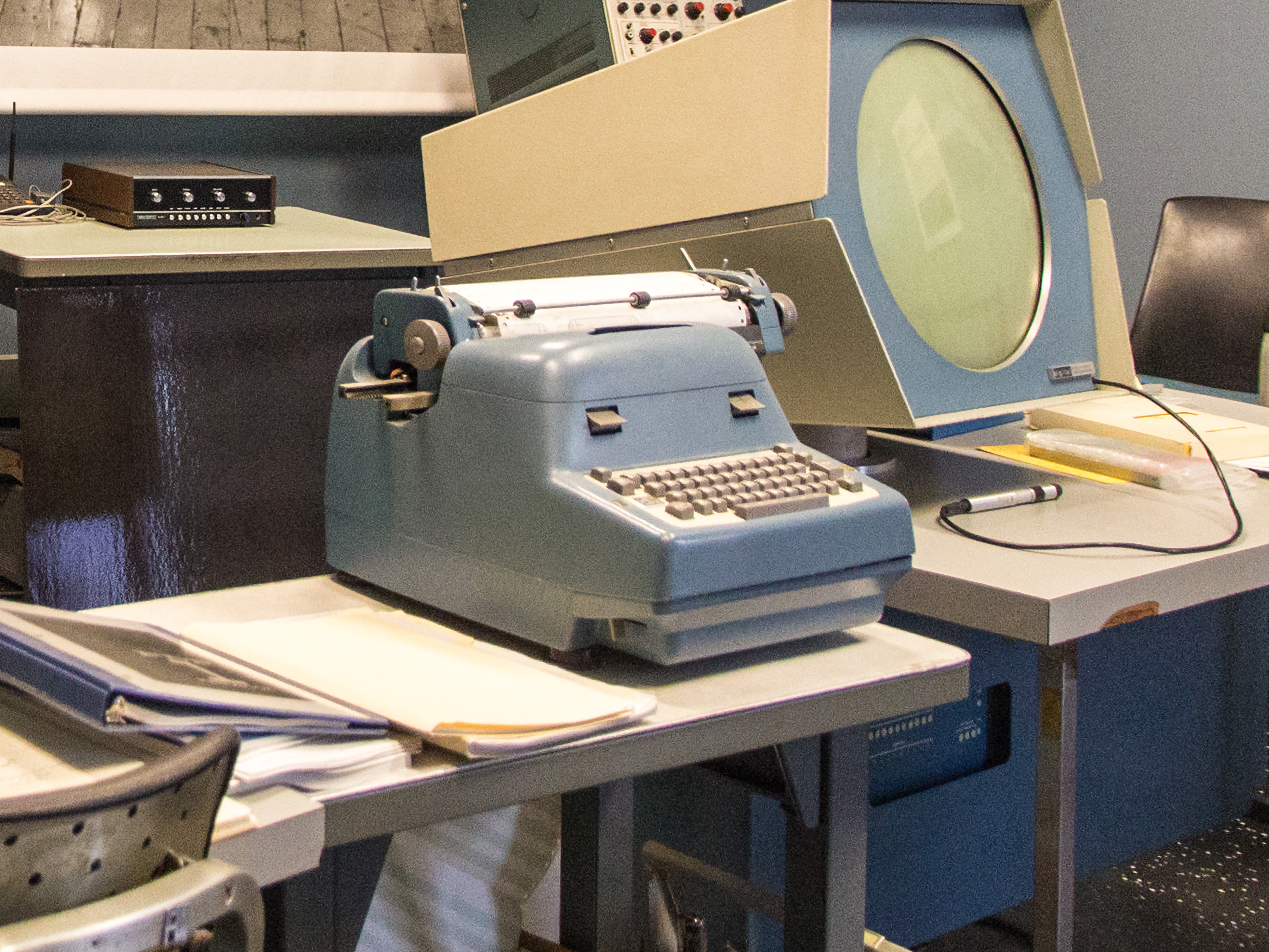
(Photo credit: Alexey Komarov, CC BY-SA 4.0)
However, around that time, IBM also started looking internally at how their typewriters could be used in conjunction with paper or magnetic tape for word processing or publishing, with much more limited hardware needs, making them more affordable and suitable for office work.
UPDATE: Here is a picture of a prototype from around 1958:
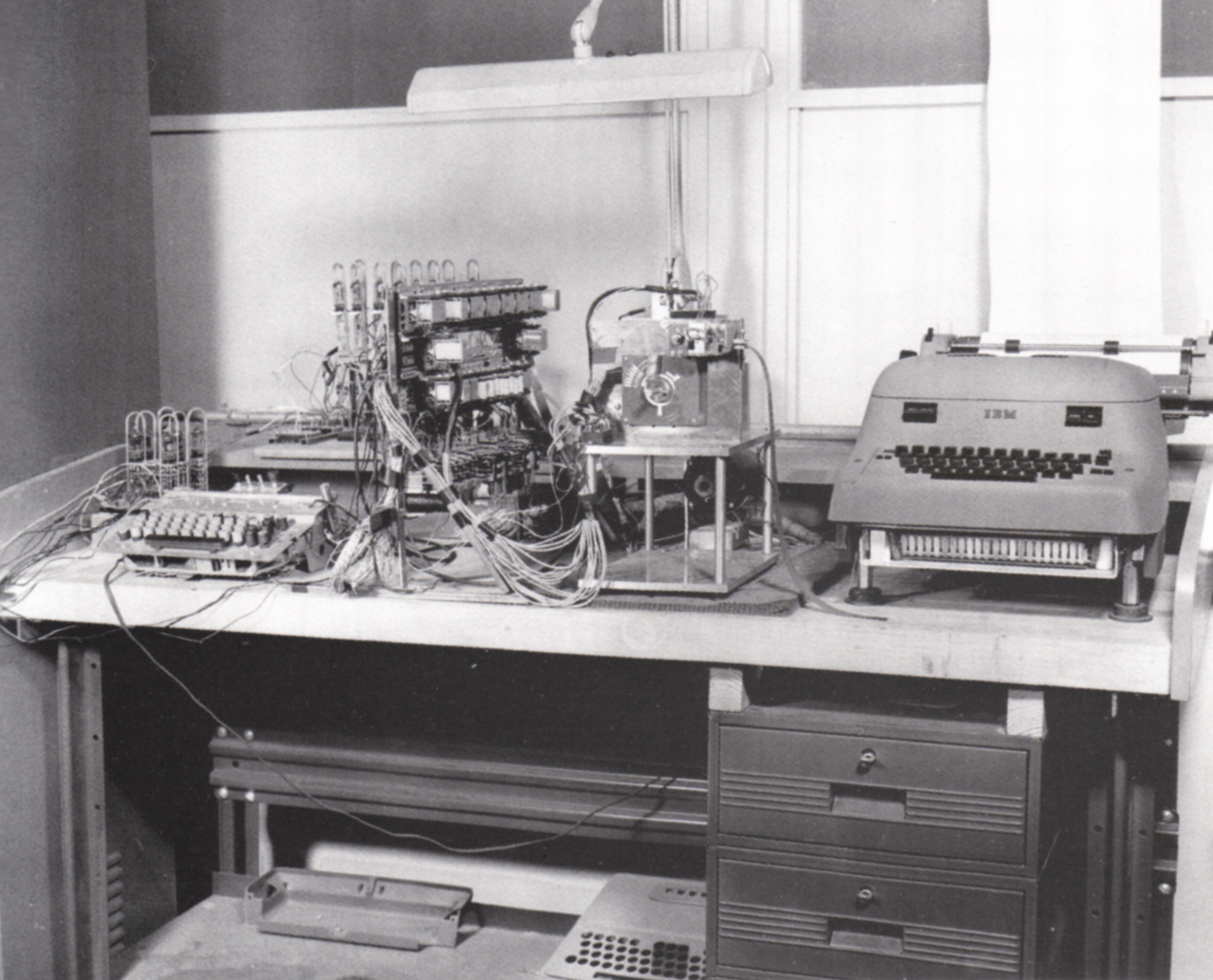
You can see:
- on the left, a keypunch for entry
- in the center, the tape drive
- on the right, the printer, which is a modified IBM Model B typewriter (or Model B I/O)
The machine’s electronics clearly feature relays, but also vacuum tubes! It is interesting to me that IBM eventually got rid of the tubes, kept the relays, but used “SMS” cards (some with transistors) instead of tubes for the rest.
It took IBM about 6 years and finally, in 1964, IBM’s MT/ST (Magnetic Tape/Selectric Typewriter), the first dedicated word processor, reached the market. It wasn’t cheap at $10,000 (or $100,000 in 2024 dollars). This was a very significant machine, and interesting in many ways. I plan to cover it in more details in a separate post.
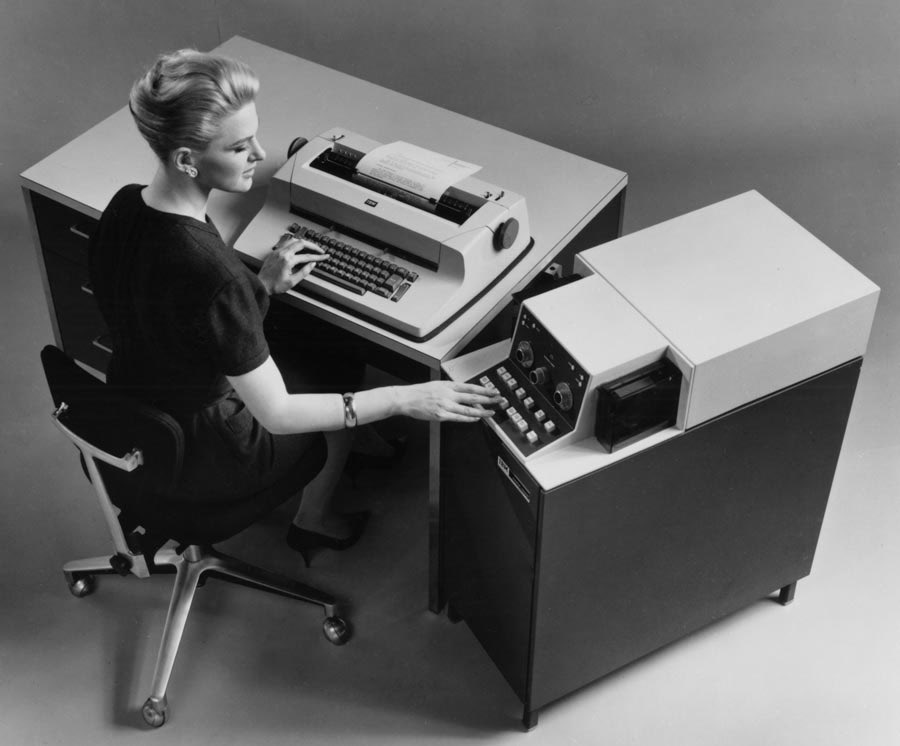
Later generations of that system progressively got more affordable and used magnetic cards (“Mag Card Selectric Typewriter”), an internal tape loop (“Memory Typewriter”), or even battery-powered RAM (“Electronic Typewriter 75”). I did manage to collect some of these machines as well.1 I covered, in particular, the Memory Typewriter and Electronic Selectric Composer in a few posts.2
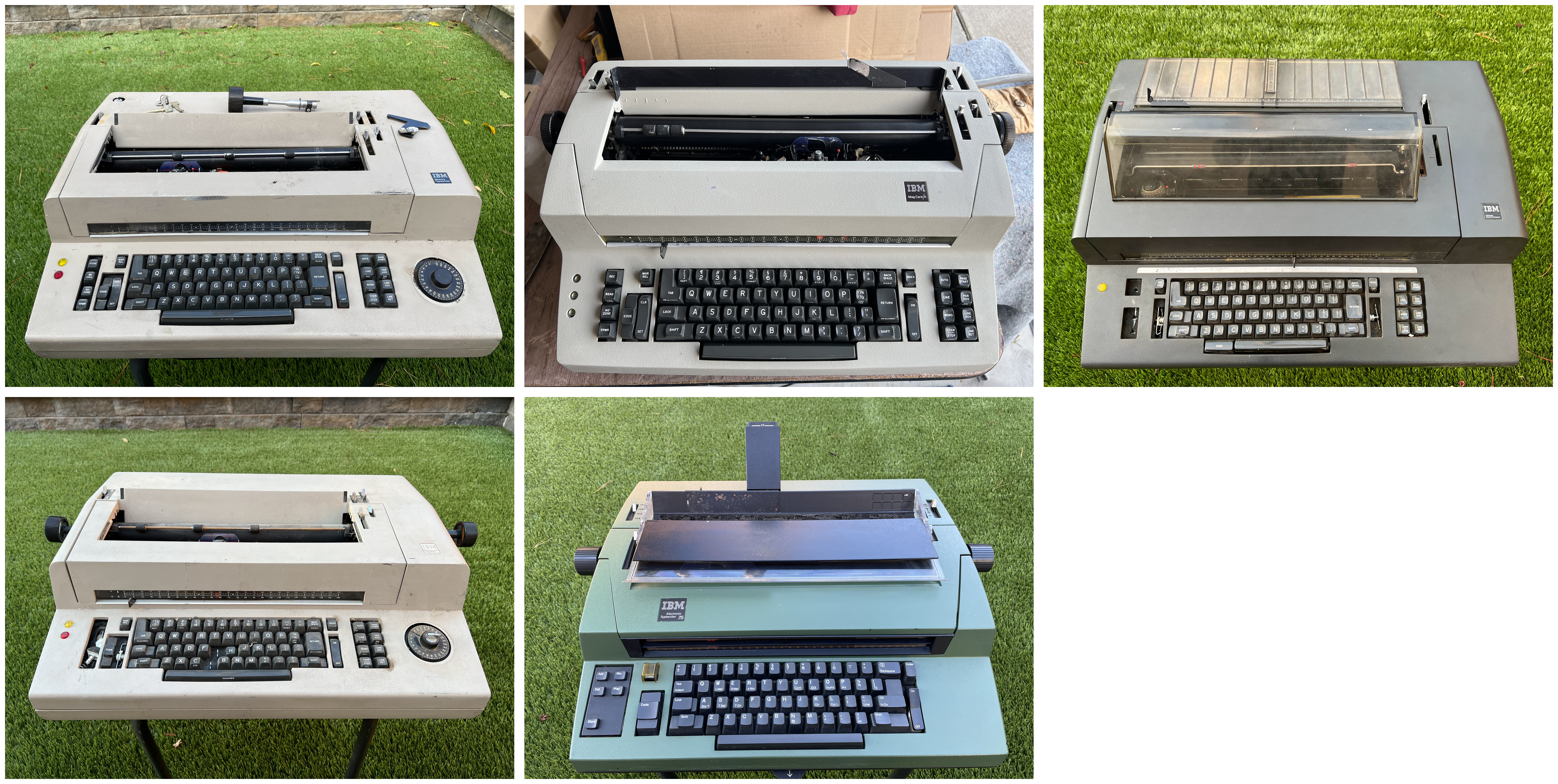
Over the last couple of years I have become (maybe a little too) fascinated with the MT/ST, and I was keeping an eye open to see if any instance would surface. Among others, I acquired a maintenance binder for the MT/ST, which I will discuss in another post; I acquired NOS (new old stock) MT/ST tapes; and I also got vaguely acquainted with a weird system called the MT/SC (Magnetic Tape/Selectric Composer), which appeared derived from the MT/ST and the IBM Composer.3 In fact, recently, I had asked in online groups whether any MT/SC might have survived, as there was no evidence online that any had. Nobody had any knowledge of a surviving system.
The find
Unexpectedly, in March, someone (thank you Brian!) tipped me that an IBM Composer was available in my area. This was already of interest to me, but on the side of the picture was clearly (to me!) an IBM tape console that looked like the one used for the MT/ST.

Would you have seen it? I am quite proud I did, but then I had been feeding myself images of the MT/ST for a while. On the other hand, retrospectively, I think I blanked on the desk console and binders when I first looked at the picture.
I immediately contacted the seller (thank you Kelly!), who confirmed the item was available, including the tape console. I dropped everything to rush to the place. This is what I saw when I arrived.

There was not only the Composer, desk and tape console, but another desk, typewriter and tape console! I was in shock. I had to have it all, but I was told that it all came together anyway. I was too excited to be quite sure what I had, but I knew that I wanted it, and that I would figure out the rest later.
I had planned for my minivan, which I hoped would be able to hold typewriter, desk, and tape console - and it did. But I hadn’t planned for two sets of these! I called a friend with a small truck, and thankfully he was able to help right away (thanks again, Darrell!).
I glimpsed into one of the tape stations, hoping to find a bank of relays like that of the full MT/ST. Instead, I saw mostly emptiness. I had a slight moment of doubt, thinking that the console might have been guttted. But luckily, it turned out not to be the case, and that, by design, these tape consoles never included relays.
After the (literal) dust settled, I realized that this was a full MT/SC system - and, possibly, the only survivor of its kind!4
First steps
Once the system was loaded, transported and unloaded, I did a round of cleaning. The goal here was twofold:
- Avoiding storing filthy machines.
- Doing a rough evaluation of the machines’ condition.
The desks, which were covered in grime, turned out to be in better cosmetic condition than expected. The top of the input station, in particular, is in excellent condition, as are the drawers. There were lots of rat excrements underneath the desk, which had to be taken care of. There is corrosion on the desk legs, which should be also addressed eventually, but it’s not too bad. Finally, one of the legs is slightly coming loose, but hopefully that is fixable.

While the desk of the input station is purely a piece of furniture without electronics, the desk of the output station contains electronics and electromechanical components, but no drawers.
I used compressed air to clean dust and dirt from the output station’s inside. The back of that unit can be closed with a large panel, which was separate when I got the machine, but which I luckily recognized for what it was and took as well.
I opened the tape consoles to check them, but only cleaned their exterior.

The consoles look better after cleaning. However, there are some scratches on the exterior panels of the input tape console, and some color stains on top. It’s unclear if there is any way to make this go away, or if some painting will be eventually needed.

The Composer station station also looks better after superficial cleaning.

What is the IBM MT/SC?
So what is, then, the IBM MT/SC (Magnetic Tape/Selectric Composer) that I obtained? Let’s put things in perspective.
IBM’s typewriter product line in the 1960s was not perfect or exactly simple, but it was sensible. They had:
- the heritage of the typebar Electromatic, including the Executive with proportional spacing (Model C in 1958, C Executive in 1959);
- the new revolutionary Selectric (now known as the Selectric I), which would soon take over so many offices (1961);
- the first word processor, using magnetic tapes, the MT/ST (1964);
- the Selectric Composer, an electromechanical typesetting machine (1966).3
Given this product lineup, it was only natural for IBM to bring together the MT/ST and the Composer by means of electronics. IBM had all the in-house technology needed for this, given that it also had a line of powerful but extremely expensive mainframe computers.5
An so the IBM MT/SC came out in 1967, quite soon after the standalone Composer’s release. This indicates that development on the system must have started much earlier. How early, we might never know!
The general idea behind the MT/SC was as follows: you would use an MT/ST to enter text and save it to tape. Then you would move the tape to the MT/SC station, which would read the tape and produce typeset text. This included proportional text, right-margin justification, and even hyphenation. The following diagram, from a 1968 IBM paper, and which I colorized, shows the general idea of the system:
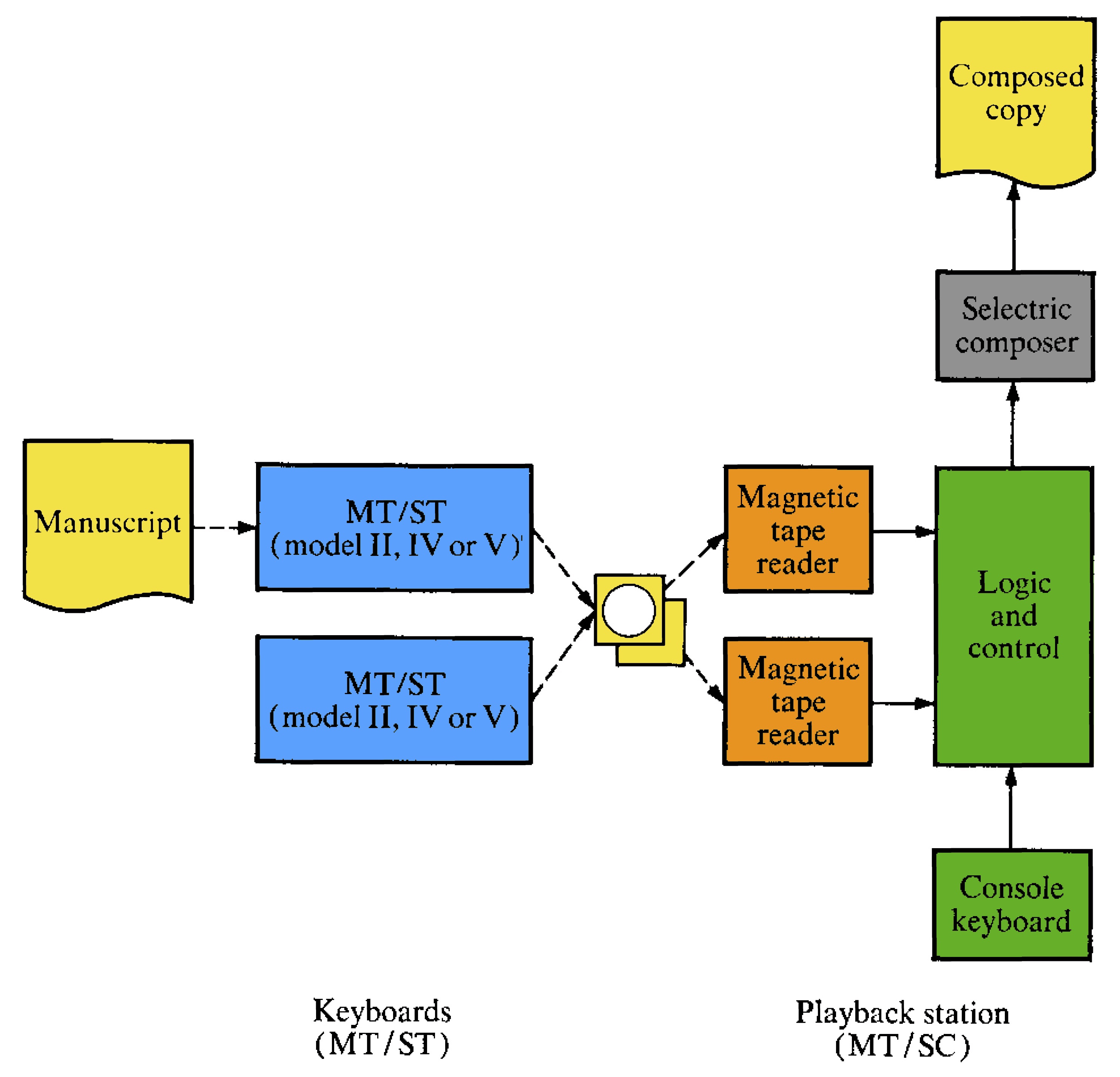
At the center of the system, in yellow, are the tapes. On the left, “Keyboards” (or input stations). On the right, the MT/SC proper (or output station, or composing station), which can read the tapes and produce the composed copy.
This had been unclear to me before obtaining this system, but a distinction must be made between the MT/SC proper, which includes the Composer, its desk, and tape console, and a full MT/SC system, which has to include the MT/SC, but also one or more input stations. In a field installation, you would have always at least one input station in addition to the MT/SC. In other words, the MT/SC cannot be used standalone, without an input station. You need a way to make the tapes containing the text to compose, and the MT/SC by itself cannot do that.
The 1966 standalone electromechanical Composer (and, before it, the Varityper) required the operator to type each line twice, making those devices slow. The MT/SC fixed that issue of slowness in a few ways:
- The Composer works from tape, and has an electronic memory, and no longer requires typing things twice.
- Text output is mostly automatic, only requiring intervention for some hyphenation decisions as well as changing fonts.
- Mistakes are more easily handled. Since the text is on tape, you can input the text once, and output it multiple times from the same tape.
- You could also have multiple operators working on text entry at the same time, on cheaper input stations, to maximize the use of the expensive composing station.
The result was high-quality text output produced much faster than with the electromechanical Composer alone. This was very important for medium-size publications, like some magazines.
As you can see, this is really a composing or publishing system not “just” a word-processing system, although word-processing with the MT/ST can absolutely be part of it.
High-level inventory
I am really lucky that the system I got also included an input station! Therefore, I obtained not only an MT/SC, but an entire MT/SC system. It consists of two main parts:
- the Magnetic Tape Selectric Recorder (MT/SR) which acts as an input station
- the Magnetic Tape Selectric Composer (MT/SC) proper (output station)
Each station includes:
- a typewriter
- a desk
- a tape console
- a green binder
Amazingly, the two maintenance binders with service diagrams are present! The binders were meant to be stored in the tape consoles, where there is a holder for that purpose. However the two binders had been left on top of the machines, where unfortunately they were exposed to some amount of rat urine. But their content was mostly intact. Each binder also includes a complete service record for each machine, showing that they entered service in 1969 and were used until at least 1978.
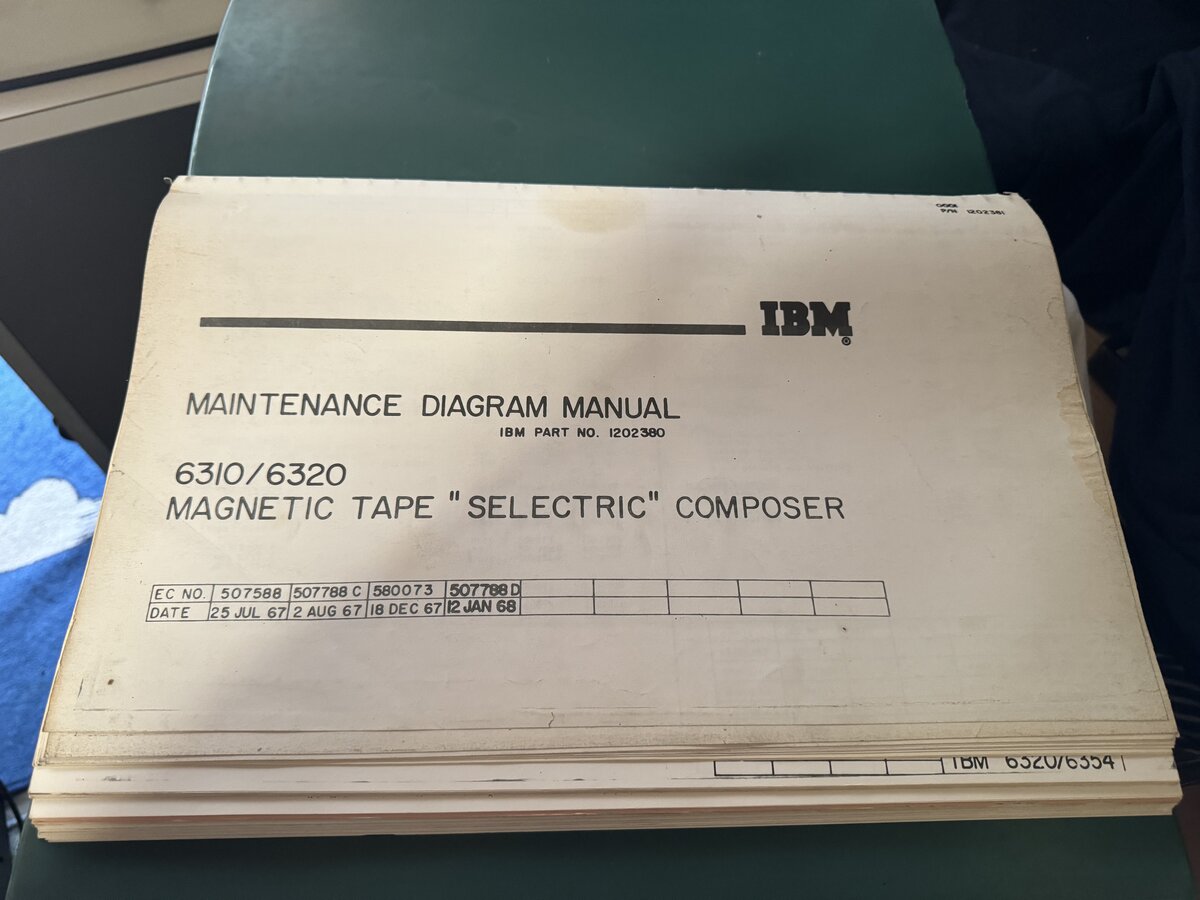
Here is the itemized “Equipment History” for the MT/SR, dated July 5, 1968:

There were also some accessories, including:
- 3 tapes that were unprotected
- 2 tapes within the MT/SC
- some ribbons
- a box with 18 type elements
- some sheets of paper
- some smaller items not directly related to the MT/SC
The input station (MT/SR)
Initial glance
First, this was an unknown system to me! The input station, at first glance, looks like an MT/ST. The main difference you can observe is that the tape console has fewer buttons. In particular, it doesn’t have the iconic dials and two-digit window for search. The tape console also has only one Tape Station (as IBM called them), on the right, with a placeholder on the left.

Compare with the MT/ST Model II, which also had only a single Tape Station, as seen below.
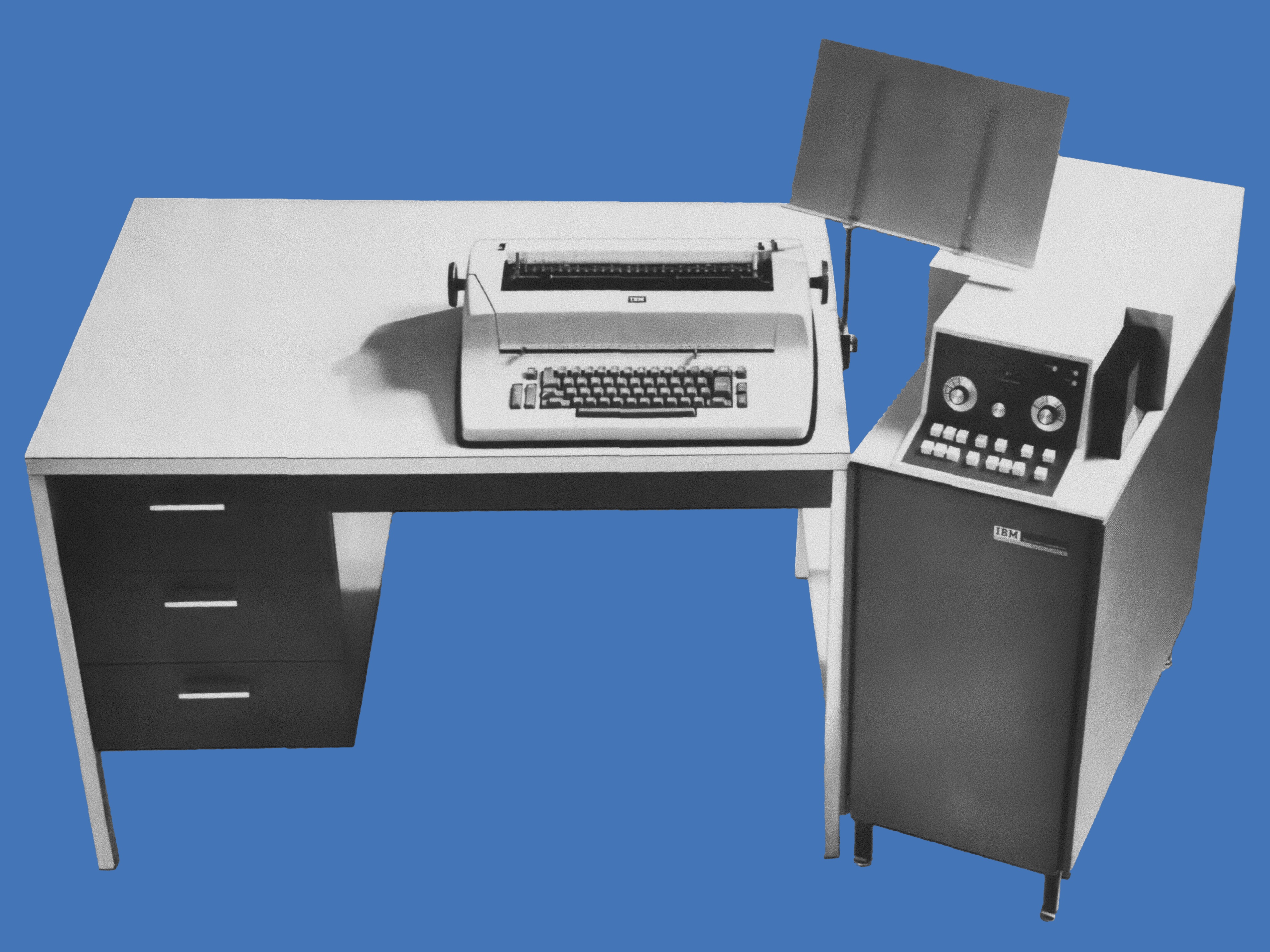
There is a single power cable for the whole system.
Naming
The input station features multiple names, which I summarize below:
| Label/Location | Model/Name | Notes |
|---|---|---|
| Inside the typewriter | MODEL: MT/SR | “Magnetic Tape/Selectric Recorder” |
| Inside the typewriter | TYPE: 655 | model of the typewriter unit |
| Maintenance Diagram Manual | Magnetic Tape “Selectric” Recorder | presumably for the whole system |
| MT/SR Equipment History sheet | 655 TYPEWRITER | clearly the model of the typewriter unit |
| Inside the tape console | MT Selectric Recorder | |
| Inside the tape console | Model 6330 | presumably the model of the tape console |
| On the tape console | Selectric Recorder / Magnetic Tape Model V | presumably for the whole system |
| 1967 sales quote from Kansas | Magnetic Tape Selectric Recorder with desk, Model V | whole system |
I will call this the “input station” or the “MT/SR” to refer to the whole input system.
The typewriter
The typewriter looks identical to the typewriter of the MT/ST. I already knew that this machine was a so-called I/O typewriter, that is, an IBM Selectric modified to be connected to computers and tape systems like the MT/ST and the MT/SR. Well, this was only partially correct, as I found out later.

Unlike the output station (see below) and later IBM Mag Card units, you can easily disconnect the magnetic tape console from the typewriter by unscrewing a connector. That connector also brings power in for the typewriter motor: there is no separate power cord for the typewriter.

The typewriter label says clearly “MODEL: MT/SR” and “TYPE: 655”. This is a hint that it is not a standard I/O typewriter, and I determined later that this is just an “input-only” typewriter, with the ability to type text and save it to tape, but not to read from tape and print. The machine features contact for input, but lacks the solenoids needed for operating the printer. In fact, there are two solenoids:
- one to activate the ribbon color switch
- one to activate the Selectric’s cycle clutch

Someone asked me if it could be possible that this was a regular I/O typewriter, but that someone took out the solenoids. I am 100% sure that this is not the case:
- The naming of the typewriter is clear: it is an MT/SR (as in “Recorder”).
- The use case for the input station is clear: it is to enter text and save it to tape, not to print it.
- There is no evidence in the typewriter’s or tape console’s buttons of anything indicating that you could switch the machine to read from tape and print.
- There is no physical evidence inside the typewriter of anything having been removed. All appears original.
My conclusion is that IBM simply produced dumbed-down I/O typewriters for input only, and that this is one of them. This would have reduced cost by a small fraction.
Now, I wish I had an actual full-fledged I/O typewriter, as it would be fun to use it s a printer, but this is not such a machine.
I might still refer to this as an “I/O typewriter” for simplicity, but from now on let’s keep in mind that this is not a regular I/O typewriter.
The I/O typewriter uses fabric ribbons in a cartridge. A spare, sealed ribbon was present, as well as another, open ribbon. The ribbon is bicolor, which is unusual for an IBM typewriter. The reason for this was that the user could enter codes using the PFX (“Prefix”) key, and the code would show in red on the paper as a differentiator.

I think that you should be able to respool a regular fabric ribbon into the cartridge, but I haven’t tried yet.
A single type element, identified by MT/SR, is present. The list of parts refers to this as “DOMESTIC PRESTIGE ELITE ELEM”.

Like the regular Selectric I/O typewriter, the machine is taller than a regular Selectric I typewriter, but the bottom part is meant to fit into a recess in a desk. The “underwater” part is almost the same height as the “above water” part.

In fact, it looks really cool when inside the desk, even better than a regular Selectric typewriter!

The typewriter can easily be removed from its desk, which was convenient for moving the whole system. It is also easy to remove the top cover the I/O typewriter without tools. Once you have done that, you can lift the inside of the typewriter in service position (shown below after removal of crumbling sound-deadening foam).

There are two obviously broken parts inside the typewriter:
- A plastic tape is broken. This is activated by a solenoid, and the purpose is to switch the ribbon from black to red. It is not an essential part, but it would be nice to fix it.
- The tab pulley is broken. This is a common issue in Selectric typewriters, and it is definitely fixable.

Here is the schematics for the ribbon color switch.

The I/O typewriter came with a dust cover.
The MT/SR keyboard is interestingly different from the standard Selectric keyboard, or from the IBM 2741 terminal’s. Note, in particular, on top of the number row:
!above1♰“cross” character above2+above3- absence of a
#sign - inclusion of quotes
‘and’
You can see the entire layout below (prior to cleaning):

This would be considered an unusual layout, except that it actually matches the standard Composer layout! It makes sense that the layouts would match, since one station is meant to be used with the other (see part 2 for a discussion of the output station).
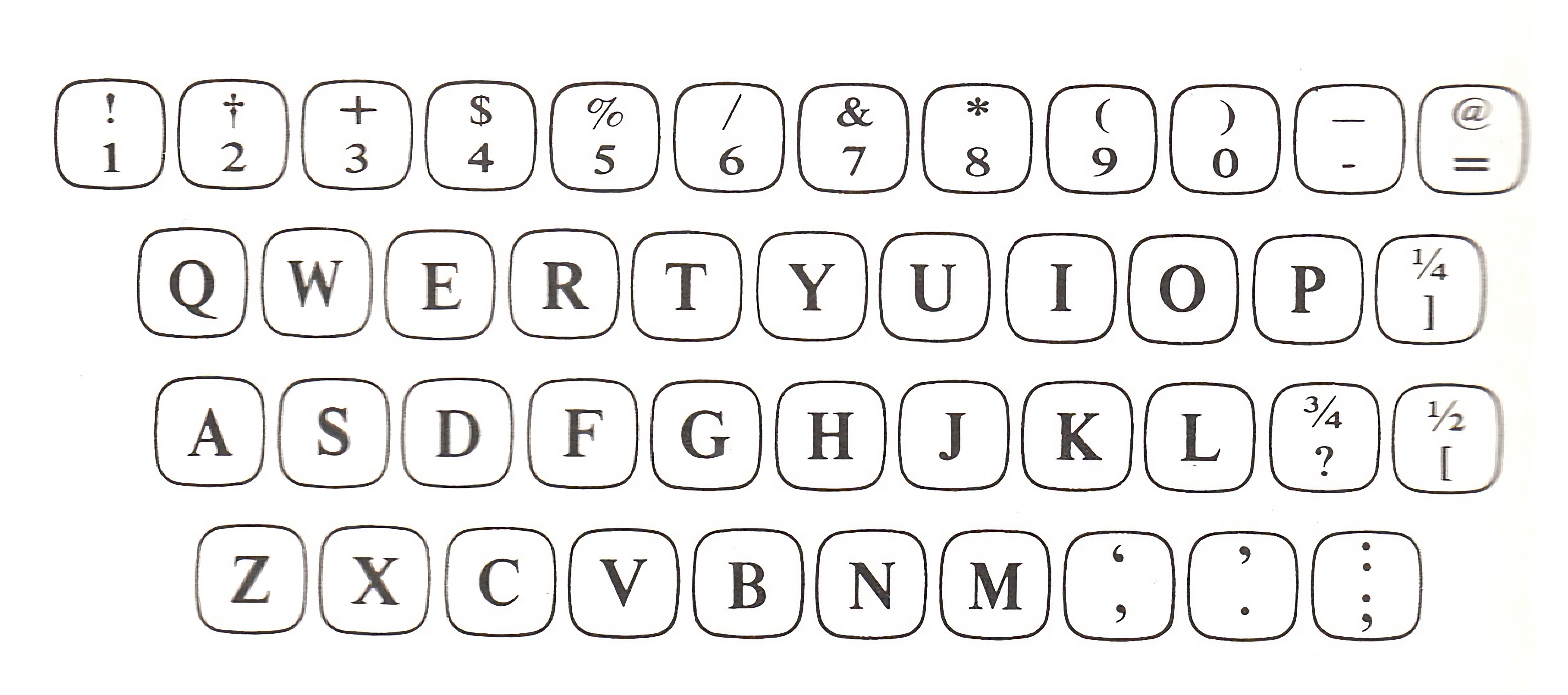
The tape console
It is easy to open the tape console: push a flat spring on the right side, then lift the rear top cover, and then the front top cover. They pivot on hinges and nicely stay open. Note the typically disintegrating foam on the top cover.
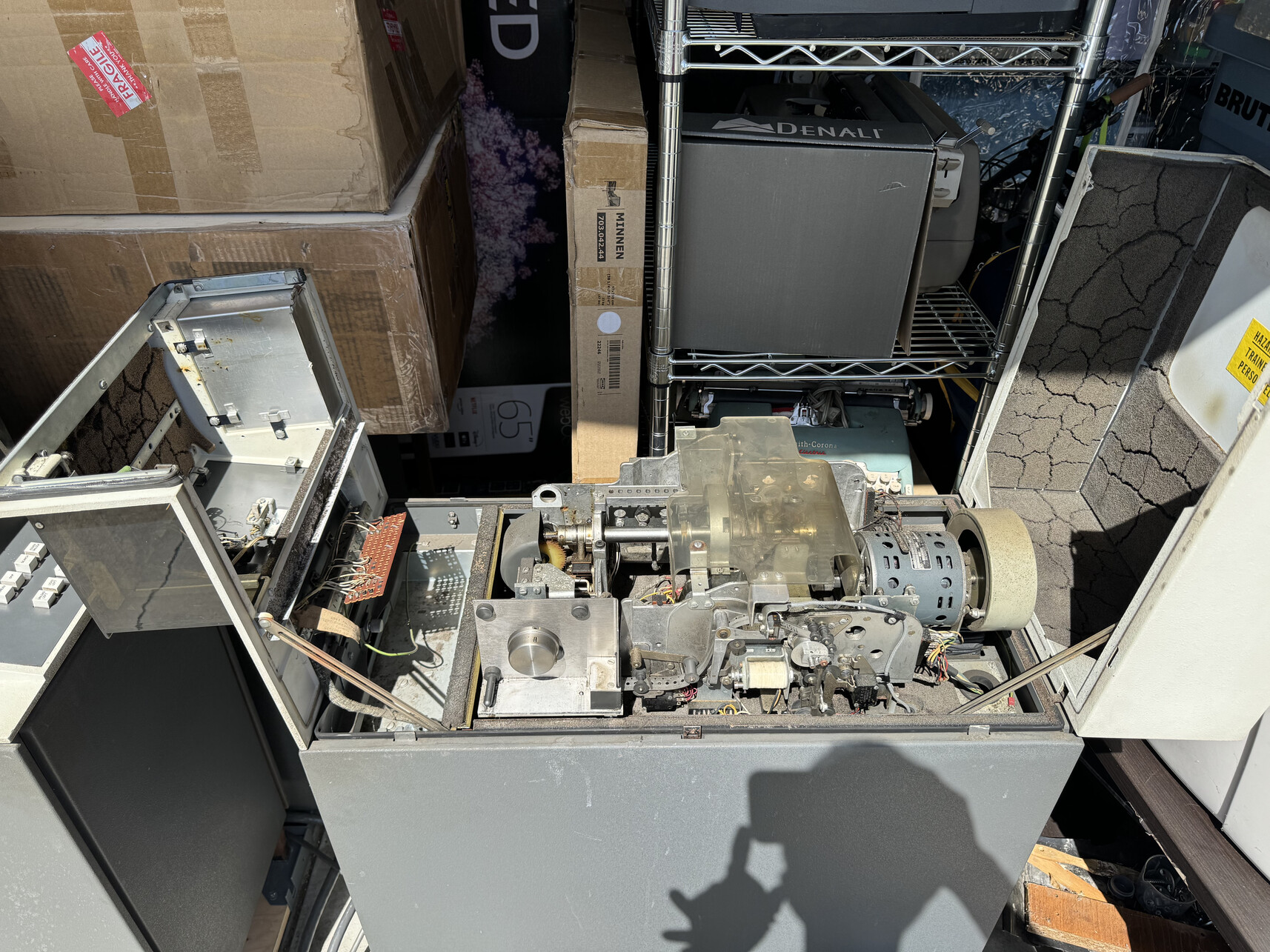
From there, you can remove the two side panels, as well as the front panel. This gives full access to the inside of the console. You see, on the right side of the console, the plastic bin that holds the tape as it is fed into the machine. Indeed, there is no pick-up spool for the magnetic tape: it just accumulates in that bin until the tape is rewound.

The top part, like for the MT/ST, contains the tape drive, including:
- motor
- gears, etc.
- the single tape station on the right
- front panel switches
The front panel includes the following:
- Indicators
- ERROR
- ON
- READY
- Record/Type toggle switch
- I believe that this allows you to toggle the machine between two modes:
- Record: the machine is in record mode, and will write to tape.
- Type: the machine works as a regular typewriter, without writing to tape.
- I believe that this allows you to toggle the machine between two modes:
- Buttons
- LINE RETURN: it is unclear how different this is from the regular RETURN key on the typewriter.
- LOAD: for loading the tape (see below).
- UNLOAD: for unloading the tape (see below).

The console is way larger than it needs to be, but it is clear that IBM just reused the full MT/ST console hardware, which needed much more space for its large relay bank. Similarly, the console’s front panel is way too large for the few buttons and indicators it contains. On the MT/ST II and IV, which have two large dials, many more buttons, and a double-digit indicator, it makes more sense.
Inside, we have a small-ish power supply, with fuses and, interestingly, two power outlets:

With the front panel removed, you can easily pivot the electronics panel, and look inside. It contains a backplane, partially wire-wrapped, and a small number of cards.
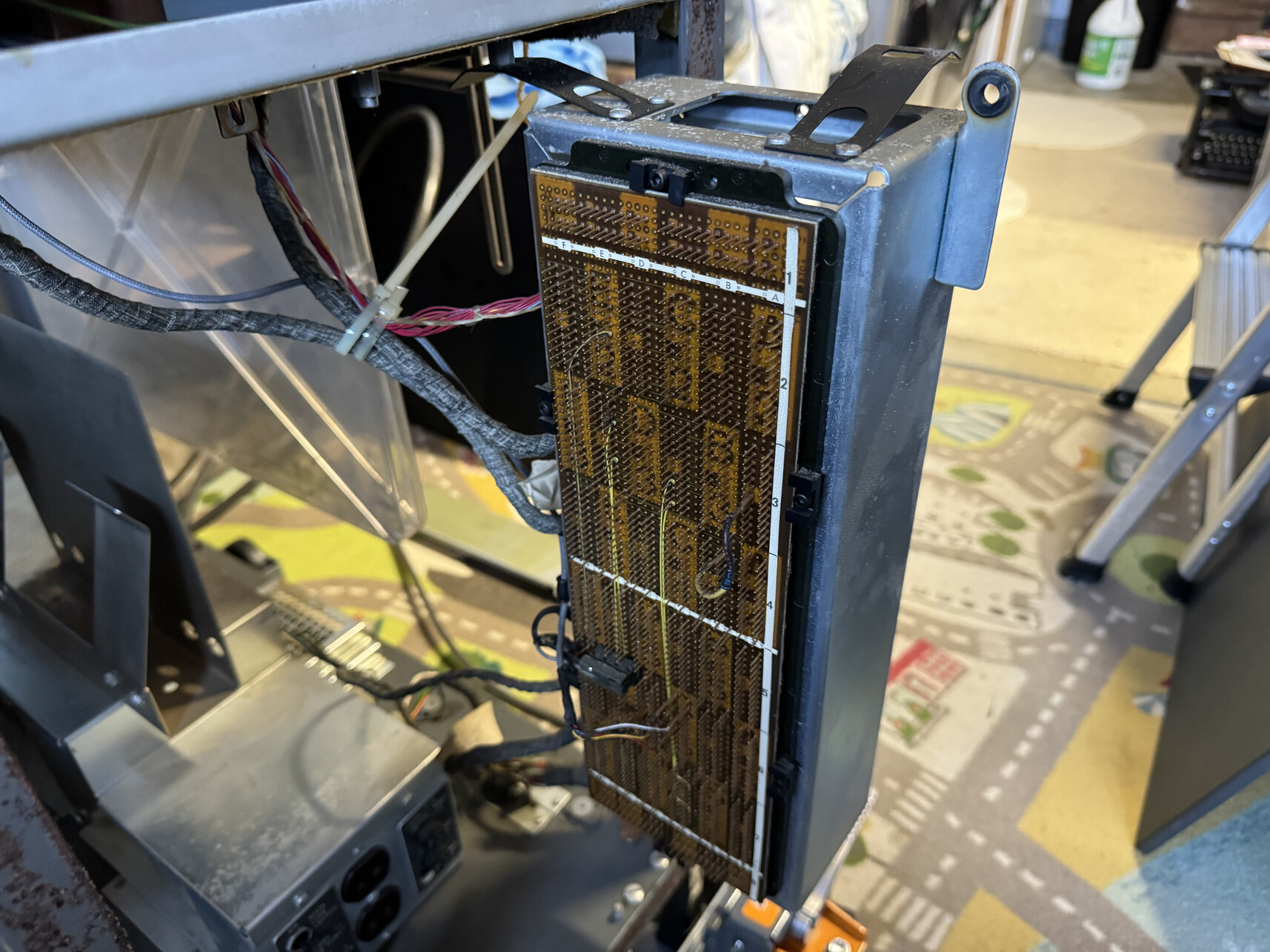
The electronics connect to the tape reader, the control panel, and the typewriter via the large “umbilical cord”.
The small power supply and electronics cage explains why the tape console appears mostly empty if you peek inside.
We should note that, while the system is write-to-tape-only, there is a limited way to edit with the “Backspace” key: while this would not erase on paper (the IBM Selectric II was not released yet), doing so would back up the tape by one character. This is a very limited form of editing, but it is there, and allows fixing at least basic typos when entering text.
The desk
Unlike the Magnetic Tape Selectric Composer desk, which contains electronics, this desk is just a piece of furniture, with the electronics in the MT console.
The desk is in very good condition. It features 3 metal drawers, which can lock with a key (which was present)!

I couldn’t help cleaning and polishing the keys right away:

The typewriter fits into a recess in the desk. A rubber ring seals the typewriter so that it fits snugly. But the typewriter actually mostly rests on a base underneath the desk top.
The cable, for both data and power, nicely routes out of the desk to the tape console unit, which includes the power supply and electronics in addition to the tape drive. This gives the system a very clean look, with just one visible cable going from the desk to the tape console, and then one power cable going from an outlet to the tape console.
Temporary conclusion
In this post, I placed the IBM MT/SC in its context, described its various parts at a high level, and covered the input station in more details. In the next part, I cover the output station, and more. See The IBM Magnetic Tape Selectric Composer - Part 2.
References
- Photo albums
- TWDB
See also Typewriter bucket list. ↩
See:
See also Restoring an IBM Electronic Selectric Composer - Part 1. ↩ ↩2
Needless to say, if you know of any other surviving MT/SC, please let me know! ↩
The typewriter business was made into a separate division, the Office Products Division, in 1964. ↩

Comments powered by Disqus.